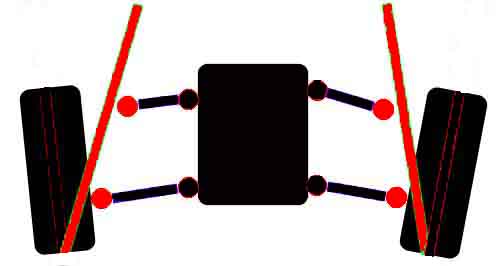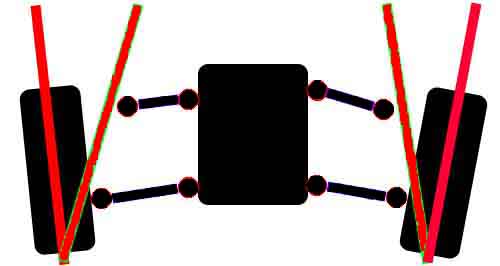- The various angles of the front axle :
- The balljoints 11°30
- The tracking 0°09 to
0°17
|
- Wheel camber 0°10 to 0°50
- Caster 2°00 to 3°00
- The inbuilt angle 11°
|
- Adjustment with string and Pastis.
- It
wasn't all that long ago that the adjustment of the front axle was done
with string for the tracking, a plumb line for the other axis, stub
axle, caster, wheel camber.
- Here is the technique for checking the tracking :
- Find
the centre of the steering by turning the wheel to full lock one way,
and count the turns to full lock the other way. Divide by 2 to give the
centre. If the steering wheel arms aren't horizontal then you have to
take off the steering wheel to readjust it.
- Take 4 plots, 2 at the front, 2 at the back and hold a string
parallel to the wheels of the car. It is necassary to leave 1 - 2 cm of play against the rear wheels.
- With a tape measure,
verify that there is enough toe-in
(see the table) between the wheels.
- To adjust the tracking you have to adjust the track rod ends.
- Obviously this work should only be done by a pro, it goes without saying ;-)
|
- The angle of the balljoints.
- This
is the line between the upper and lower balljoints. When the vehicle is
raised (or is lifted) the wheels get closer togther at the bottom, and
further apart when the vehicle is lowered.
|

|
- The tracking (Toe-in).
- When
the car is raised the wheels tend to squeeze together (as on the
diagram), and when it is lowered the wheels get further apart.
|

|
- Wheel Camber.
- The
adjustment of the wheel camber makes it possible to make the rotational
axis coincide (when one turns the wheel) with the middle of the tyre.
See the drawing 'The inbuilt angle'.
|

|
- Caster.
- Effectively
it's the fork of a bicycle. It has the advantage of always allowing the
car to keep its wheels in a straight line. When you turn the wheels,
thereby raising the car, its weight puts them straight again !
|

|
- The inbuilt angle.
- This
angle cannot be adjusted, it is checked to verify if the front axle is
in good condition. On the drawing, one can clearly see the intersection
of the axes of the balljoints and camber that allow the tyre to rotate
around its centre.
|

|
|
Lifting, lengthening the axles, wider tyres, un-original rims, and all modifications to the front axle :
All these modifications will alter the fragile equilibrium of the front axle!
The advantage of the Lada Niva is that everything is adjustable, once you know how.
|
| Thanks to hoverfrog
for this translation. |
